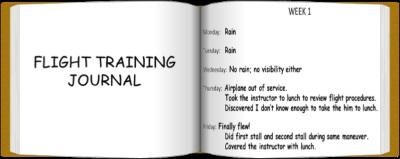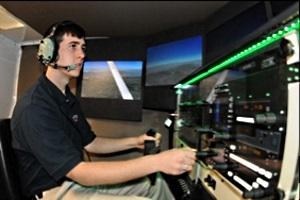An Airplane Makes A Terrible Classroom
By Jerry Gregoire
Up until recently, flight simulators for universities and small-to-medium sized flight schools fell into one of two extreme categories, one being simulators that were far too expensive for the average private flight school to afford and the other being simulators that were well suited only for more advanced instrument training. Primary skills training such as flight maneuvers, visual navigation, communications, etc. was confined to the real airplane.

An airplane makes a terrible classroom. That’s because, (and this should be intuitively obvious to anyone), flying airplanes is dangerous. There is risk involved with strapping oneself into a vehicle that hurtles down a runway, lifts you a few thousand feet into the air and accelerates to hundreds of miles per hour. The only perfectly safe airplane is one that never leaves the ground and even then you run the risk of being hit by another aircraft. Furthermore, there are lessons that are crucial to skilled piloting that, for safety’s sake, simply should not be taught in a real airplane.
The establishment of the Advanced Aircraft Training Device (AATD) category by the FAA in July of 2008 did little in its certification criteria to advance the use of simulation in ab-initio training, using instead their remarkable grasp of 1960s technology to concentrate, once again, on features aimed primarily at instrument training. The AATD rules did, however, open the door for innovation and differentiation by allowing manufacturers to add enhancing technologies to the device without risk of decertification and, just as importantly, made it possible to certify a simulator model once, at the manufacturer’s facility, and have the certification automatically apply to all of the units shipped anywhere in the United States. Now this is a rare bit of common sense, especially when compared to most of the rest of the planet, including Canada and Europe, where every simulator, ones that are identical in every way to the first one certified, must be individually certified at each customer’s
location, every year! This amazing bit of bureaucratic make work has had a hugely negative impact on safety by artificially limiting access to a valuable training tool thereby increasing the cost of training in places where training costs are already highest in the world.
There have been a variety of surveys given to student pilots since 2001 in an attempt to understand, among other things, the low rates of completion in flight training. Among the questions in the surveys, participants were asked to rank the most difficult things to master in the airplane. As one might expect, the respondents ranked landings as the most difficult, but one item consistently in the top 3 or 4 turned out to be, “talking on the radio”. Perhaps it shouldn’t come as that much of a surprise. As you watch primary students master flying one gets the impression that the push-to-talk button on the yoke must be somehow cabled to the ailerons as every radio call seems to be accompanied by a departure from straight and level flight.

Aviation communication is concentration and multi-tasking, phraseology and lingo, frequencies, timing, tuning your ear, and knowing when and what to ask for. Learning to talk on the radio in a classroom or by sitting in front of a computer is like learning to play the clarinet by listening to Benny Goodman records, it’s just not going to teach you much until you pick up the instrument and make a noise. The question the designers need to ask is: Do we really need to burn 100LL fuel in order to learn how to communicate effectively with ATC? The answer is, no. Generation 2 simulators are making this possible.
In Part III, You're Either Part Of The Solution Or Part Of The Particulate.
(Images provided by the Author)
(Jerry Gregoire is the founder and owner of Redbird Flight Simulations)
 ANN's Daily Aero-Term (05.01.24): Say Altitude
ANN's Daily Aero-Term (05.01.24): Say Altitude ANN's Daily Aero-Linx (05.01.24)
ANN's Daily Aero-Linx (05.01.24) Classic Aero-TV: Korean War Hero Twice Reborn
Classic Aero-TV: Korean War Hero Twice Reborn Airborne 04.29.24: EAA B-25 Rides, Textron 2024, G700 Deliveries
Airborne 04.29.24: EAA B-25 Rides, Textron 2024, G700 Deliveries Airborne Affordable Flyers 05.02.24: Bobby Bailey, SPRG Report Cards, Skydive!
Airborne Affordable Flyers 05.02.24: Bobby Bailey, SPRG Report Cards, Skydive!




